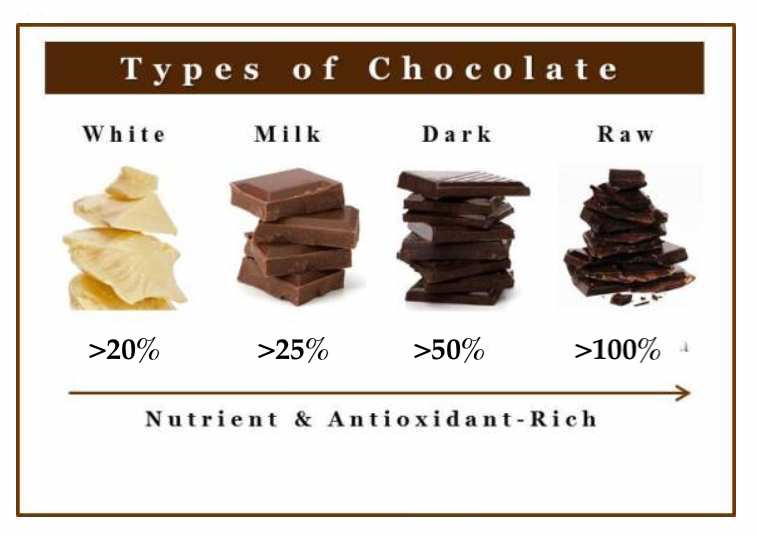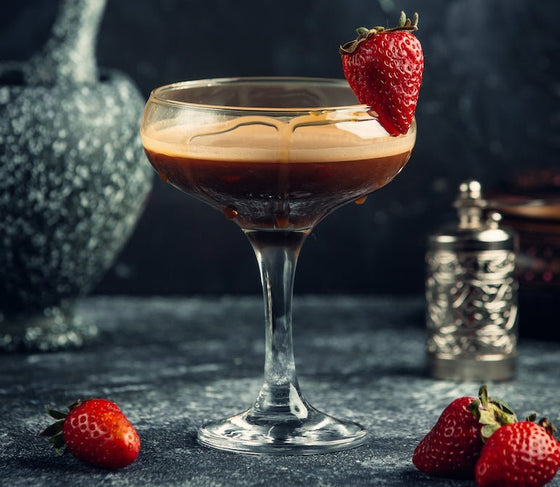

Not only do we have white, milk and dark chocolate types (and of course the recently created ‘Ruby’ chocolate), but within those chocolate types, you will also find products with differing cocoa percentages.
On the back of most chocolate product packaging you’ll find the ingredients list and one of the first constituents listed should be the amount or percentage of cocoa solids. You may have wondered what this means, what the difference is and whether you’ll be more or less likely to enjoy the taste.
Generally speaking a high cocoa percentage means the chocolate will be dark, whereas a lower percentage means the chocolate will be milk, but the following is a simple guide to follow so you’ll know what percentage to look for to find your ideal tasting bar of chocolate.
The cocoa percentage listed is simply the amount of cocoa the chocolate producer has chosen to put into their bar, and is important as it lets the consumer know how many cocoa solids have been used to flavour the bar – the higher the percentage, the stronger the cocoa flavour.
In the UK, the Cocoa and Chocolate Products Legislation states that milk chocolate must contain at least 25% cocoa solids to be legally called milk chocolate, there is however no minimum for dark chocolate and can be found containing anything from 50% to 100% cocoa solids.
Although white chocolate doesn’t contain any cocoa ‘solids’, it does contain cocoa butter which gives it that creamy flavour, and in the UK white chocolate must contain a minimum of 20% cocoa butter to be legally sold as ‘chocolate’.
In addition to being an indicator of taste and texture, cocoa percentage is also an indicator of quality. In some cases, a low cocoa percentage suggests the chocolate contains a higher quantity of cheaper additives or sugar (often to mask the fact that your chocolate doesn’t taste that ‘chocolatey’). Additionally, in the US, milk chocolate is only required to contain a percentage of 10% cocoa solids (see US FDA's standards of Identity for chocolate) so if you’re looking for a rich, chocolatey tasting bar, always check the cocoa percentage first to avoid munching on a bar of ‘sugar’.

(Photo credit - dchealthybites.com)
Cocoa solids are naturally bitter so the higher the dark chocolate cocoa percentage, the richer your bar will be. Dark chocolate can be found with varying cocoa percentages and although taste preferences vary from person to person (making a lower cocoa percentage more palatable to some), to really appreciate the rich cocoa tones, a minimum of 70% cocoa solids provides the best example of flavour.

However, you’re a dark chocolate-devotee you may want to opt for a richer 80% plus bar like our Purist Bar (80% dark chocolate) or Midnight Ginger (80% dark chocolate with sweet and fiery crystallised ginger).
100% cocoa solids chocolate – although containing no other additives, they do contain cocoa butter (naturally present in cocoa solids) which allows it to be moulded into a bar and still melt on the tongue, but as there is no added sugar, be prepared for a very, strong ‘cocoa’ rather than ‘chocolate’ flavour.
As well as having a lower percentage of the potentially bitter tasting cocoa solids than dark chocolate, milk chocolate contains ‘milk’ (hence the name), which not only lightens the colour of the chocolate but adds a subtle sweetness which softens the intensity of the cocoa bean flavour.

Although the minimum is 20% cocoa solids, a minimum of 30% cocoa solids allows you to still enjoy the delicate notes of cocoa, without the bitter-sweet edge of a dark chocolate. Our entire Milk chocolate range contains a minimum of 34% cocoa solids.
Recently, some companies have introducing product lines commonly classed as ‘Dark Milk’ containing cocoa percentages of 40% or more, for those looking for a slightly stronger, richer cocoa flavour whilst still retaining the sweetness of a milk chocolate.
As mentioned earlier, white chocolate doesn’t contain any cocoa solids but does contain cocoa butter - the fatty substance derived from the cocoa bean which gives chocolate it’s creamy texture. White chocolate is very delicate, and as it doesn’t have the flavour depth of the cocoa solids, some companies get away with using lower cocoa butter percentages, and bulk up with artificial flavours, vegetable fats or lots of sugar. But by choosing a white chocolate with a minimum of 30%, the subtle, yet fragrant, notes of cocoa butter should still be experienced enabling the velvety texture and delicate taste of white chocolate to shine through.
In a nutshell…..
The cocoa percentage decision is yours. Taste preference varies tremendously from one person to another, so whether you enjoy munching on moreish milk, whimsical white or devilishly dark chocolate, always check out the percentage of cocoa solids in your bar - it’s a great excuse to try out lots of different options, discover likes and dislikes and get the most out of your chocolate.

Dive into a few delicious and inventive chocolate cocktails that will please any chocolate lover!
New Retails Sales Partner - The Coffin Works Museum, Birmingham


